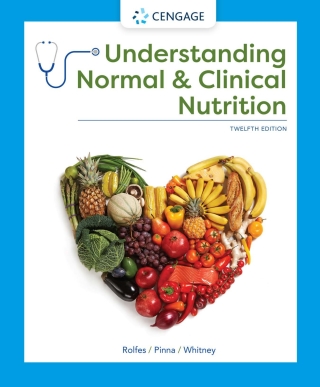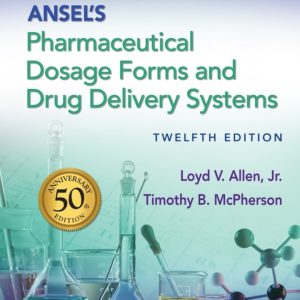Buy Understanding Normal and Clinical Nutrition, 12th Edition PDF ebook by author Sharon Rady Rolfes; Kathryn Pinna; Ellie Whitney – published by Cengage Learning in 2021 and save up to 80% compared to the print version of this textbook. With PDF version of this textbook, not only save you money, you can also highlight, add text, underline add post-it notes, bookmarks to pages, instantly search for the major terms or chapter titles, etc.
You can search our site for other versions of the Understanding Normal and Clinical Nutrition, 12th Edition PDF ebook. You can also search for others PDF ebooks from publisher Cengage Learning, as well as from your favorite authors. We have thousands of online textbooks and course materials (mostly in PDF) that you can download immediately after purchase.
Note: e-textBooks do not come with access codes, CDs/DVDs, workbooks, and other supplemental items.
eBook Details:
Full title: Understanding Normal and Clinical Nutrition, 12th Edition
Edition: 12th
Copyright year: 2021
Publisher: Cengage Learning
Author: Sharon Rady Rolfes; Kathryn Pinna; Ellie Whitney
ISBN: 9780357368251, 9780357368244
Format: PDF
Description of Understanding Normal and Clinical Nutrition, 12th Edition:
This updated 12th Edition of UNDERSTANDING NORMAL AND CLINICAL NUTRITION presents the fundamentals of nutrition and nutrition therapy along with their practical applications to daily life and clinical settings. Starting with normal nutrition, the authors introduce nutrients and their physiological impacts, as well as nutritional guidelines for good health and disease prevention. Coverage of clinical nutrition includes the latest information on pathophysiology and dietary changes for treating a variety of medical conditions, from obesity and pregnancy to cardiovascular diseases, diabetes, and HIV. Known for a consistent and student-friendly narrative, the book includes systematic “How To” discussions, clinical case studies, review questions, and in-depth “Highlight” sections to help students master key topics,Important Notice: Media content referenced within the product description or the product text may not be available in the ebook version.
Table of Contents of Understanding Normal and Clinical Nutrition, 12th Edition PDF ebook:
Brief ContentsTable of ContentsPrefaceAcknowledgmentsReviewers of Understanding Normal & Clinical NutritionChapter 1: An Overview of Nutrition1.1 Food Choices1.2 The Nutrients1.3 The Science of Nutrition1.4 Dietary Reference Intakes1.5 Nutrition Assessment1.6 Diet and HealthReferencesHighlight 1: Nutrition Information and MisinformationChapter 2: Planning a Healthy Diet2.1 Principles and Guidelines2.2 Diet-Planning Guides2.3 Food LabelsReferencesHighlight 2: Vegetarian DietsChapter 3: Digestion, Absorption, and Transport3.1 Digestion3.2 Absorption3.3 The Circulatory Systems3.4 The Health and Regulation of the GI TractReferencesHighlight 3: Common Digestive ProblemsChapter 4: The Carbohydrates: Sugars, Starches, and Fibers4.1 The Chemist’s View of Carbohydrates4.2 Digestion and Absorption of Carbohydrates4.3 Glucose in the Body4.4 Health Effects and Recommended Intakes of Sugars4.5 Health Effects and Recommended Intakes of Starch and FibersReferencesHighlight 4: Carbs, kCalories, and ControversiesChapter 5: The Lipids: Triglycerides, Phospholipids, and Sterols5.1 The Chemist’s View of Fatty Acids and Triglycerides5.2 The Chemist’s View of Phospholipids and Sterols5.3 Digestion, Absorption, and Transport of Lipids5.4 Lipids in the Body5.5 Health Effects and Recommended Intakes of Saturated Fats, Trans Fats, and Cholesterol5.6 Health Effects and Recommended Intakes of Monounsaturated and Polyunsaturated FatsReferencesHighlight 5: High-Fat Foods-Friend or Foe?Chapter 6: Protein: Amino Acids6.1 The Chemist’s View of Proteins6.2 Digestion and Absorption of Proteins6.3 Proteins in the Body6.4 Protein in Foods6.5 Health Effects and Recommended Intakes of ProteinReferencesHighlight 6: Nutritional GenomicsChapter 7: Energy Metabolism7.1 Chemical Reactions in the Body7.2 Breaking Down Nutrients for Energy7.3 Feasting and FastingReferencesHighlight 7: Alcohol in the BodyChapter 8: Energy Balance and Body Composition8.1 Energy Balance8.2 Energy In: The kCalories Foods Provide8.3 Energy Out: The kCalories the Body Expends8.4 Body Weight and Body Composition8.5 Health Risks Associated with Body Weight and Body FatReferencesHighlight 8: Eating DisordersChapter 9: Weight Management: Overweight, Obesity, and Underweight9.1 Overweight and Obesity9.2 Causes of Overweight and Obesity9.3 Problems of Overweight and Obesity9.4 Aggressive Treatments for Obesity9.5 Weight-Loss Strategies9.6 UnderweightReferencesHighlight 9: The Latest and Greatest Weight-Loss Diet-AgainChapter 10: The Water-Soluble Vitamins: B Vitamins and Vitamin C10.1 The Vitamins-An Overview10.2 The B Vitamins10.3 Vitamin CReferencesHighlight 10: Vitamin and Mineral SupplementsChapter 11: The Fat-Soluble Vitamins: A, D, E, and K11.1 Vitamin A and Beta-Carotene11.2 Vitamin D11.3 Vitamin E11.4 Vitamin KReferencesHighight 11: Antioxidant Nutrients in Disease PreventionChapter 12: Water and the Major Minerals12.1 Water and the Body Fluids12.2 The Minerals-An Overview12.3 The Major MineralsReferencesHighlight 12: Osteoporosis and CalciumChapter 13: The Trace Minerals13.1 The Trace Minerals-An Overview13.2 The Trace Minerals13.3 Contaminant MineralsReferencesHighlight 13: Phytochemicals and Functional FoodsChapter 14: Life Cycle Nutrition: Pregnancy and Lactation14.1 Nutrition prior to Pregnancy14.2 Growth and Development during Pregnancy14.3 Maternal Weight14.4 Nutrition during Pregnancy14.5 High-Risk Pregnancies14.6 Nutrition during LactationReferencesHighlight 14: Fetal Alcohol SyndromeChapter 15: Life Cycle Nutrition: Infancy, Childhood, and Adolescence15.1 Nutrition during Infancy15.2 Nutrition during Childhood15.3 Nutrition during AdolescenceReferencesHighlight 15: Childhood Obesity and the Early Development of Chronic DiseasesChapter 16: Life Cycle Nutrition: Adulthood and the Later Years16.1 Nutrition and Longevity16.2 The Aging Process16.3 Energy and Nutrient Needs of Older Adults16.4 Nutrition-Related Concerns of Older Adults16.5 Food Choices and Eating Habits of Older AdultsReferencesHighlight 16: Hunger and Community NutritionChapter 17: Nutrition Care and Assessment17.1 Nutrition in Health Care17.2 Nutrition AssessmentReferencesHighlight 17: Nutrition and ImmunityChapter 18: Nutrition Intervention18.1 Implementing Nutrition Care18.2 Energy Intakes in Hospital Patients18.3 Dietary Modifications18.4 FoodserviceReferencesHighlight 18: Food AllergiesChapter 19: Medications, Diet-Drug Interactions, and Herbal Products19.1 Medications in Disease Treatment19.2 Diet-Drug Interactions19.3 Herbal ProductsReferencesHighlight 19: Complementary and Alternative MedicineChapter 20: Enteral Nutrition Support20.1 Oral Supplements20.2 Tube Feedings in Medical Care20.3 Enteral Formulas20.4 Administration of Tube FeedingsReferencesHighlight 20: Inborn Errors of MetabolismChapter 21: Parenteral Nutrition Support21.1 Indications for Parenteral Nutrition21.2 Parenteral Solutions21.3 Administering Parenteral Nutrition21.4 Nutrition Support at HomeReferencesHighlight 21: Ethical Issues in Nutrition CareChapter 22: Metabolic and Respiratory Stress22.1 The Body’s Responses to Stress and Injury22.2 Nutrition Treatment of Acute Stress22.3 Respiratory StressReferencesHighlight 22: Multiple Organ Dysfunction SyndromeChapter 23: Upper Gastrointestinal Disorders23.1 Conditions Affecting the Esophagus23.2 Conditions Affecting the Stomach23.3 Gastric SurgeryReferencesHighlight 23: Oral Health and Chronic IllnessChapter 24: Lower Gastrointestinal Disorders24.1 Common Intestinal Problems24.2 Malabsorption24.3 Conditions Affecting the Pancreas24.4 Conditions Affecting the Small Intestine24.5 Conditions Affecting the Large IntestineReferencesHighlight 24: Probiotics and Intestinal HealthChapter 25: Liver Disease and Gallstones25.1 Fatty Liver and Hepatitis25.2 Cirrhosis25.3 Liver Transplantation25.4 Gallstone DiseaseReferencesHighlight 25: Anemia in IllnessChapter 26: Diabetes Mellitus26.1 Overview of Diabetes Mellitus26.2 Treatment of Diabetes Mellitus26.3 Diabetes Management in PregnancyReferencesHighlight 26: The Metabolic SyndromeChapter 27: Cardiovascular Diseases27.1 Atherosclerosis27.2 Coronary Heart Disease (CHD)27.3 Stroke27.4 Hypertension27.5 Heart FailureReferencesHighlight 27: Coping with Feeding DisabilitiesChapter 28: Kidney Diseases28.1 Functions of the Kidneys28.2 The Nephrotic Syndrome28.3 Acute Kidney Injury28.4 Chronic Kidney Disease28.5 Kidney StonesReferencesHighlight 28: DialysisChapter 29: Cancer and HIV Infection29.1 Cancer29.2 HIV InfectionReferencesHighlight 29: Foodborne IllnessAppendixesAppendix A: Cells, Hormones, and NervesAppendix B: Basic Chemistry ConceptsAppendix C: Biochemical Structures and PathwaysAppendix D: Measures of Protein QualityAppendix E: Nutrition Assessment: Supplemental InformationAppendix F: Estimated Energy NeedsAppendix G: Choose Your Foods: Food Lists for Diabetes and Weight ManagementAppendix H: Aids to CalculationAppendix I: WHO Nutrition RecommendationsAppendix J: Healthy People 2020Appendix K: Enteral FormulasGlossaryIndex





